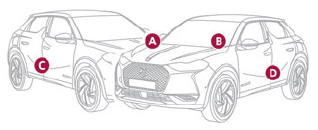DS 3: DS CONNECT RADIO / Media
USB port
 Insert the USB memory stick
into the USB
port or connect the USB device to the USB
port using a suitable cable (not supplied).
Insert the USB memory stick
into the USB
port or connect the USB device to the USB
port using a suitable cable (not supplied).
 To
protect the system, do not use a USB
hub.
To
protect the system, do not use a USB
hub.
The system builds playlists (in temporary memory); this operation can take from a few seconds to several minutes at the first connection.
Reduce the number of non-music files and the number of folders to reduce the waiting time.
Playlists are updated whenever the ignition is switched off or a USB memory stick is connected.
The audio system memorises these lists, which will subsequently load faster if they have not been changed.
Auxiliary (AUX) jack socket
Depending on equipment
 Connect a portable device (MP3
player,
etc.) to the auxiliary jack socket using an
audio cable (not supplied).
Connect a portable device (MP3
player,
etc.) to the auxiliary jack socket using an
audio cable (not supplied).
This source is only available if "Auxiliary input" has been selected in the audio settings.
First adjust the volume on the portable device (to a high level). Then adjust the volume of the audio system.
Controls are managed via the portable device.
Selecting the source
 Press Radio Media to
display the main
page.
Press Radio Media to
display the main
page.
Press the "SOURCES" button.
Select the source.
BluetoothStreaming®
Streaming allows you to listen to the audio feed from your smartphone.
The Bluetooth profile must be activated.
First adjust the volume on the portable device (to a high level). Then adjust the volume of the system.
If play does not start automatically, it may be necessary to start the audio playback from the smartphone.
Control is from the portable device or by using the system's touch buttons.
 Once
connected in Streaming mode, the
smartphone is considered to be a media
source.
Once
connected in Streaming mode, the
smartphone is considered to be a media
source.
Connecting Apple® players
Connect the Apple® player to the USB socket using a suitable cable (not supplied).
Play starts automatically.
Control is via the audio system.
 The
classifications available are those of
the portable device connected (artists/albums/genres/playlists/audio books/podcasts).
It is also possible to use a
classification structured in the form of a
library.
The
classifications available are those of
the portable device connected (artists/albums/genres/playlists/audio books/podcasts).
It is also possible to use a
classification structured in the form of a
library.
The default classification used is by artist. To modify the classification used, return to the first level of the menu then select the desired classification (playlists for example) and confirm to go down through the menu to the desired track.
The version of software in the audio system may not be compatible with the generation of the Apple® player.
Information and advice
The system supports USB mass storage devices, BlackBerry® devices or Apple® players via the USB ports. The adapter cable is not supplied.
Devices are managed using the audio system controls.
Other devices, not recognised on connection, must be connected to the auxiliary socket using a jack cable (not supplied) or via Bluetooth streaming, if compatible.
 To
protect the system, do not use a USB
hub.
To
protect the system, do not use a USB
hub.
The audio system will only play audio files with ".wav", ".wma", ".aac", ".ogg" and ".mp3" file extensions, at bit rates between 32 Kbps and 320 Kbps.
It also supports VBR (Variable Bit Rate) mode. No other file types (".mp4", etc.) can be read.
All ".wma" files must be standard WMA 9 files.
The supported sampling rates are 11, 22, 44 and 48 KHz.
To avoid reading and display problems, we recommend choosing file names less than 20 characters long that do not contain any special characters (e.g. “ ? . ; ù).
Use only USB memory sticks in FAT32 format (File Allocation Table).
 We
recommend using the original USB
cable for the portable device.
We
recommend using the original USB
cable for the portable device.
 DAB (Digital Audio Broadcasting) radio
DAB (Digital Audio Broadcasting) radio
Terrestrial Digital Radio
Digital radio provides higher quality sound.
The various "multiplexes/ensembles" offer a
choice of radio stations organised in alphabetical
order...
 Telephone
Telephone
USB sockets
Depending on equipment, for more information
on the USB sockets compatible with CarPlay® or
Android Auto applications, refer to the "Ease of
use and comfort" section...
Other information:
DS 3 2016-2025 Owners Manual: Free-wheeling
In certain situations, it is necessary to put the vehicle into free-wheeling mode (e.g. towing, on a rolling road, automatic car wash (Wash mode), rail or sea transport). The procedure varies according to the type of gearbox and parking brake. With a manual gearbox and electric parking brake To release them With the engine running and while depressing the brake pedal, move the gear select..
DS 3 2016-2025 Owners Manual: Localised Assistance Call
If the vehicle breaks down, press button 2 for more than 2 seconds to request assistance (confirmed by a voice message*). Pressing again immediately cancels the request. Privacy mode allows you to manage the level of sharing (data and/or location) between your vehicle and DS AUTOMOBILES. It can be configured in the Settings menu on the touch screen. By default, depending on equipme..
Categories
- Manuals Home
- 1st Generation DS 3 Owners Manual
- 1st Generation DS 3 Service Manual
- Child lock
- SCR system
- Energy economy mode. Load reduction mode
- New on site
- Most important about car
Identification markings
Various visible markings for vehicle identification and vehicle search.

